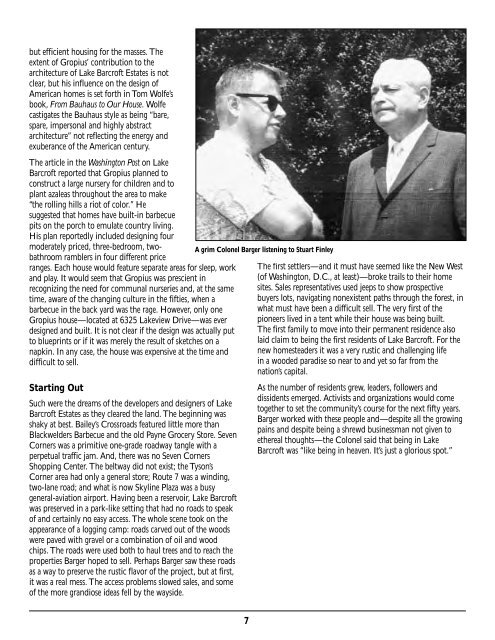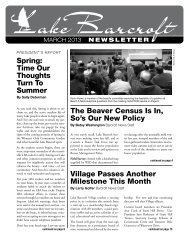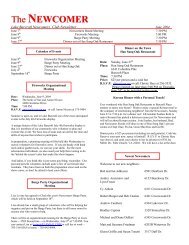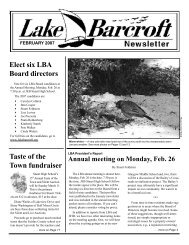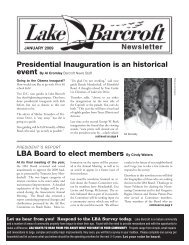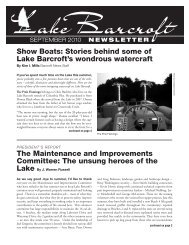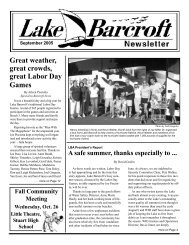Lake Barcroft History Book
Lake Barcroft History Book
Lake Barcroft History Book
Create successful ePaper yourself
Turn your PDF publications into a flip-book with our unique Google optimized e-Paper software.
ut efficient housing for the masses. The<br />
extent of Gropius’ contribution to the<br />
architecture of <strong>Lake</strong> <strong>Barcroft</strong> Estates is not<br />
clear, but his influence on the design of<br />
American homes is set forth in Tom Wolfe’s<br />
book, From Bauhaus to Our House. Wolfe<br />
castigates the Bauhaus style as being “bare,<br />
spare, impersonal and highly abstract<br />
architecture” not reflecting the energy and<br />
exuberance of the American century.<br />
The article in the Washington Post on <strong>Lake</strong><br />
<strong>Barcroft</strong> reported that Gropius planned to<br />
construct a large nursery for children and to<br />
plant azaleas throughout the area to make<br />
“the rolling hills a riot of color.” He<br />
suggested that homes have built-in barbecue<br />
pits on the porch to emulate country living.<br />
His plan reportedly included designing four<br />
moderately priced, three-bedroom, twobathroom<br />
ramblers in four different price<br />
ranges. Each house would feature separate areas for sleep, work<br />
and play. It would seem that Gropius was prescient in<br />
recognizing the need for communal nurseries and, at the same<br />
time, aware of the changing culture in the fifties, when a<br />
barbecue in the back yard was the rage. However, only one<br />
Gropius house—located at 6325 <strong>Lake</strong>view Drive—was ever<br />
designed and built. It is not clear if the design was actually put<br />
to blueprints or if it was merely the result of sketches on a<br />
napkin. In any case, the house was expensive at the time and<br />
difficult to sell.<br />
Starting Out<br />
Such were the dreams of the developers and designers of <strong>Lake</strong><br />
<strong>Barcroft</strong> Estates as they cleared the land. The beginning was<br />
shaky at best. Bailey’s Crossroads featured little more than<br />
Blackwelders Barbecue and the old Payne Grocery Store. Seven<br />
Corners was a primitive one-grade roadway tangle with a<br />
perpetual traffic jam. And, there was no Seven Corners<br />
Shopping Center. The beltway did not exist; the Tyson’s<br />
Corner area had only a general store; Route 7 was a winding,<br />
two-lane road; and what is now Skyline Plaza was a busy<br />
general-aviation airport. Having been a reservoir, <strong>Lake</strong> <strong>Barcroft</strong><br />
was preserved in a park-like setting that had no roads to speak<br />
of and certainly no easy access. The whole scene took on the<br />
appearance of a logging camp: roads carved out of the woods<br />
were paved with gravel or a combination of oil and wood<br />
chips. The roads were used both to haul trees and to reach the<br />
properties Barger hoped to sell. Perhaps Barger saw these roads<br />
as a way to preserve the rustic flavor of the project, but at first,<br />
it was a real mess. The access problems slowed sales, and some<br />
of the more grandiose ideas fell by the wayside.<br />
A grim Colonel Barger listening to Stuart Finley<br />
7<br />
The first settlers—and it must have seemed like the New West<br />
(of Washington, D.C., at least)—broke trails to their home<br />
sites. Sales representatives used jeeps to show prospective<br />
buyers lots, navigating nonexistent paths through the forest, in<br />
what must have been a difficult sell. The very first of the<br />
pioneers lived in a tent while their house was being built.<br />
The first family to move into their permanent residence also<br />
laid claim to being the first residents of <strong>Lake</strong> <strong>Barcroft</strong>. For the<br />
new homesteaders it was a very rustic and challenging life<br />
in a wooded paradise so near to and yet so far from the<br />
nation’s capital.<br />
As the number of residents grew, leaders, followers and<br />
dissidents emerged. Activists and organizations would come<br />
together to set the community’s course for the next fifty years.<br />
Barger worked with these people and—despite all the growing<br />
pains and despite being a shrewd businessman not given to<br />
ethereal thoughts—the Colonel said that being in <strong>Lake</strong><br />
<strong>Barcroft</strong> was “like being in heaven. It’s just a glorious spot.”


